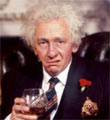From a column by Robert Novak, dated 1/16/05:
UNION VIOLENCE
More than a dozen conservative groups have joined to launch a campaign to end organized labor's 70-year-old exemption from anti-violence prohibitions under federal racketeering laws.
The coalition is getting behind a new bill introduced by Republican Congressman Joe Wilson of South Carolina. The measure would overrule a landmark 1973 Supreme Court decision confirming that union violence cannot be prosecuted under the racketeering statute if it is done in pursuit of legitimate union objectives.
In promoting Wilson's bill, conservatives are aiming at individual union members who complain about being intimidated by the union leadership. Conservatives want to protect the 40 percent of union members who voted for George W. Bush from union leaders, who send 96 percent of their political contributions to Democrats.
Over the years, murders and worse have been excused or overlooked when they occur under the guise of union activity; it's about time this was addressed, don't you think?







 Reply With Quote
Reply With Quote








 ).
).
Bookmarks